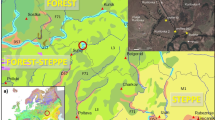Summary
The present study sums up the results of pollen analyses showing that in Czechoslovakia climax virgin coniferous forests existed at middle altitudes (ca 300–700 m ASL), where such forests have not previously been postulated to any great extent.
The average pollen spectra (Fig. 1) dating back to the early Subatlantic Period, i.e. to a period climatically similar to the present one, suggest that these forests can be divided into two main types:
-
A)
coniferous forest dominated by Abies alba but with an admixture of Picea excelsa and Pinus silvestris.
-
B)
coniferous forest dominated by Ploca excelsa with varying amounts of Pinus silvestris and low representation of Abies alba.
In neither case any significant representation of deciduous trees (Quercus spec. or Fagus silvatica) is postulated.
The geographical distribution of pollen diagrams with a ‘coniferous’ type of pollen spectrum in SA 1, the distribution of the place name of ‘Cerný les’ (Black Forest) denoting a coniferous forest usually with dominant Abies, and the oldest archive documents available, were taken into account when drafting a map of the probable distribution, or higher representation, of past virgin coniferous forests in Czechoslovakia. It shows that a higher occurrence of the first type (A) dominated by Abies can be postulated for the edge of the Českomoravská vrchovina Highlands (including the Železné hory Mtns), the Chebská pánev and Českobudějovieká panev Basins, in the eastern part of the Svitavské vrchy Hills in the Opavské vrchy Hills and the neighbouring slopes of the Nizký Jesenik Mountains, in the Ostravská pánev Basin and in the neighbouring parts of the Beskydy Mtns foothills. Lower occurrence can be postulated in the central part of the Českomoravská vrchovina Highlands, in the neighbourhood of Plzeň (the Rokycanská vrchovina Hills), in the eastern foothills of the Brdy Mtns, in the Orlické hory Mtns foothills and sporadically also elsewhere.
In the intermontane basins of the Western Carpathians, the existence of coniferous forests of the second type (B), dominated by Picea, can be considered to be demonstrated beyond reasonable doubt in the Spišská and Oravská kotlina Basins. Their occurrence in the Liptovská and Turčianska kotlina Basins is probable but their extent and significance have still to be demonstrated palynologically.
Zusammenfassung
Der vorliegende Arbeit fasst die Ergebnisse der bisherigen Pollenanalysen aus der Tschechoslowakei zusammen, die die Ursprünglichkeit der Klimax-Nadelwälder in den mittleren Lagen (ca. 300–700 M.ü.d.M.) unseres Gebietes, wo derartige Waldtypen bis jetzt im grösseren Masse nicht vermutet werden, nachweisen.
Auf Grund der Analysen der durchschníttlichen Pollenspektren, die aus dem älteren Subatlantikum stammen, also aus elnem Zeitabschnitt, der unseren heutigen klimatischen Verhältnissen sehr ähnlich ist, gelangen die Verfasser zum Schluss, dass die ursprünglichen, durch den Menschen nicht beeinflussten Nadelbestände in unserem Gebiet in zwei Haupttypen zerfielen:
-
1.
Nadelwälder mit überwiegender Ables alba und beigemischter Picea excelsa, bzw, Pinus silvestris.
-
2.
Nadelwälder mit dominierender Picea excelsa, mit veränderlicher Beimischung von Pinus silvestris und pur geringer Vertretung von Abies alba.
In keinem der beiden Fälle wird eine bedeutendere Vertretung der Laubgehölze (Quercus sp. div. oder Fagus silvatica) vorausgesetzt.
Auf Grund der geographischen Verteilung der Pollendiagramme mit dem ‘Nadeltyp’ des Pollenspektrums im ältaren Subatlantikum, ferner auf Grund der Verbreitung des Ortsnamens ‘Černý les’ oder ‘Schwarzwald’, der in unserem Geblet einen Nadelwald mit überwiegender Abies zu bezeichnen pflegt, und auf Grund der ältesten Archivdokumente wurde eine Karte der wahrscheinlichen Verbreitung, bzw. höherer Vertretung der ursprünglichen Nadelwälder im Gebiet der CSSR zusammengestellt. Aus ihr folgt, dass wir ein häufigeres Vorkommen des ersten Typs mit einem Übergewicht der Tanne vor allem in Randgebieten der Böhmisch-Mährischen Höhe (einschl. Železné hory Berge) voraussetzen können, ferner in den Becken Chebská pánev und Českobudějovieká pánev, im östlichen Teil des Hügellandes Svitavská pahorkatina, im Hügelland Opavská pahorkatina und an den anliegenden Hängen des Gebirges Nizký Jesenik, im Becken Ostravská pánev und in den angrenzenden Teilen des Hügellandes Podbeskydská pahorkatina. Ein geringes Auftreten dieses Typs kann man auch im Zentrum der Böhmisch-Mährischen Höhe voraussetzen, ferner in der Umgebung der Stadt Pizeň (Hügelland Rokycanská pahorkatina), im östlichen Brdy-Vorgebirge, im Hügelland Podorlická pahorkatina und vereinzelt bestimmt auch anderswe.
In den karpatischen Gebirgsbecken können wir die Nadelwälder des zweiten Typs, d.h. Wälder mit überwiegender Picea in den Becken Spišska kotlina und Oravská kotlina als nachgewiesen betrachten. Wahrscheinlich kommen sie auch in den Becken Liptovská kotlina, bzw. Turěianská kotlina vor, aber der Umfang und die Bedeutung ihres Vorkommens müssen erst überprüft werden.
Similar content being viewed by others
References
Hadač, E. 1965. Poznámky k syntaxonomil karpatských jendllin, (Bemerkungen zur Syntaxonomie der karpatischen Tannenwälder.), Biológia, Bratislava 20: 592–599.
Hofman, J. 1955, Rozšfrenf dřevinj podle místních názvů. (Woody plants distribution based upon place names). In: Čermál. K. (ed.) Lesnický a myslivecký atlas, Praha. map. 29.
Jankovská, V. 1967. Vývoj vegetase Třeboňske
Author information
Authors and Affiliations
Additional information
Nomenclature of vascular plants follows E. Janchen (1956–1959), Catalogus Florae Austriae. Springer, Wien; mosses: J. Podpěra (1954), Conspectus Muscorum Europaeorum, Praha; phytosociological units: J. Holub & al. (1967), Übersicht der höheren Vegetationseinheiten der Tschechoslowakel. Academia, Praha.
We should like to acknowledge the useful suggestions made by J. Moravec and R. Neuhäusl. For linguistic revision of the English text we are indebted to D.D. Bartley, University of Leeds.
Rights and permissions
About this article
Cite this article
Rybníček, K., Rybníčková, E. Palynological and historical evidence of virgin coniferous forests at middle altitudes in Czechoslovakia. Vegetatio 36, 95–103 (1978). https://doi.org/10.1007/BF00221836
Accepted:
Issue Date:
DOI: https://doi.org/10.1007/BF00221836




